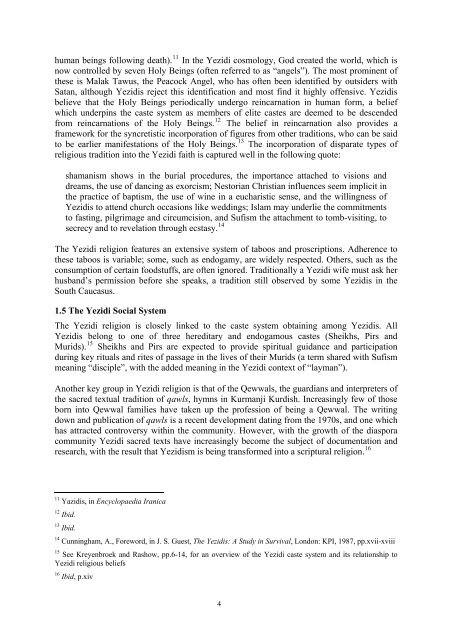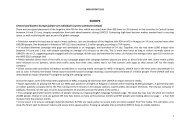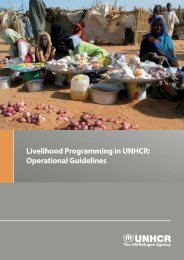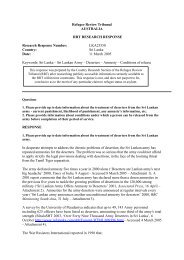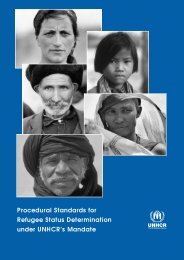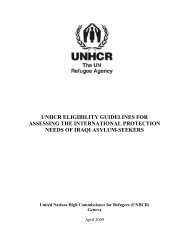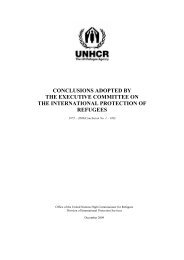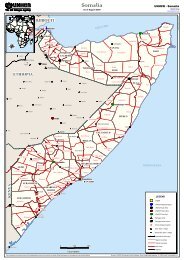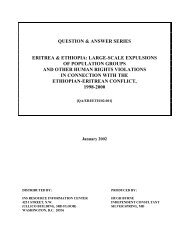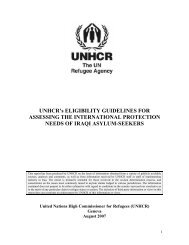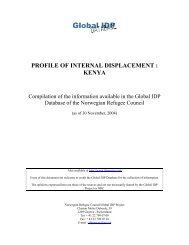The Human Rights situation of the Yezidi minority - UNHCR
The Human Rights situation of the Yezidi minority - UNHCR
The Human Rights situation of the Yezidi minority - UNHCR
You also want an ePaper? Increase the reach of your titles
YUMPU automatically turns print PDFs into web optimized ePapers that Google loves.
human beings following death). 11 In <strong>the</strong> <strong>Yezidi</strong> cosmology, God created <strong>the</strong> world, which is<br />
now controlled by seven Holy Beings (<strong>of</strong>ten referred to as “angels”). <strong>The</strong> most prominent <strong>of</strong><br />
<strong>the</strong>se is Malak Tawus, <strong>the</strong> Peacock Angel, who has <strong>of</strong>ten been identified by outsiders with<br />
Satan, although <strong>Yezidi</strong>s reject this identification and most find it highly <strong>of</strong>fensive. <strong>Yezidi</strong>s<br />
believe that <strong>the</strong> Holy Beings periodically undergo reincarnation in human form, a belief<br />
which underpins <strong>the</strong> caste system as members <strong>of</strong> elite castes are deemed to be descended<br />
from reincarnations <strong>of</strong> <strong>the</strong> Holy Beings. 12 <strong>The</strong> belief in reincarnation also provides a<br />
framework for <strong>the</strong> syncretistic incorporation <strong>of</strong> figures from o<strong>the</strong>r traditions, who can be said<br />
to be earlier manifestations <strong>of</strong> <strong>the</strong> Holy Beings. 13 <strong>The</strong> incorporation <strong>of</strong> disparate types <strong>of</strong><br />
religious tradition into <strong>the</strong> <strong>Yezidi</strong> faith is captured well in <strong>the</strong> following quote:<br />
shamanism shows in <strong>the</strong> burial procedures, <strong>the</strong> importance attached to visions and<br />
dreams, <strong>the</strong> use <strong>of</strong> dancing as exorcism; Nestorian Christian influences seem implicit in<br />
<strong>the</strong> practice <strong>of</strong> baptism, <strong>the</strong> use <strong>of</strong> wine in a eucharistic sense, and <strong>the</strong> willingness <strong>of</strong><br />
<strong>Yezidi</strong>s to attend church occasions like weddings; Islam may underlie <strong>the</strong> commitments<br />
to fasting, pilgrimage and circumcision, and Sufism <strong>the</strong> attachment to tomb-visiting, to<br />
secrecy and to revelation through ecstasy. 14<br />
<strong>The</strong> <strong>Yezidi</strong> religion features an extensive system <strong>of</strong> taboos and proscriptions. Adherence to<br />
<strong>the</strong>se taboos is variable; some, such as endogamy, are widely respected. O<strong>the</strong>rs, such as <strong>the</strong><br />
consumption <strong>of</strong> certain foodstuffs, are <strong>of</strong>ten ignored. Traditionally a <strong>Yezidi</strong> wife must ask her<br />
husband’s permission before she speaks, a tradition still observed by some <strong>Yezidi</strong>s in <strong>the</strong><br />
South Caucasus.<br />
1.5 <strong>The</strong> <strong>Yezidi</strong> Social System<br />
<strong>The</strong> <strong>Yezidi</strong> religion is closely linked to <strong>the</strong> caste system obtaining among <strong>Yezidi</strong>s. All<br />
<strong>Yezidi</strong>s belong to one <strong>of</strong> three hereditary and endogamous castes (Sheikhs, Pirs and<br />
Murids). 15 Sheikhs and Pirs are expected to provide spiritual guidance and participation<br />
during key rituals and rites <strong>of</strong> passage in <strong>the</strong> lives <strong>of</strong> <strong>the</strong>ir Murids (a term shared with Sufism<br />
meaning “disciple”, with <strong>the</strong> added meaning in <strong>the</strong> <strong>Yezidi</strong> context <strong>of</strong> “layman”).<br />
Ano<strong>the</strong>r key group in <strong>Yezidi</strong> religion is that <strong>of</strong> <strong>the</strong> Qewwals, <strong>the</strong> guardians and interpreters <strong>of</strong><br />
<strong>the</strong> sacred textual tradition <strong>of</strong> qawls, hymns in Kurmanji Kurdish. Increasingly few <strong>of</strong> those<br />
born into Qewwal families have taken up <strong>the</strong> pr<strong>of</strong>ession <strong>of</strong> being a Qewwal. <strong>The</strong> writing<br />
down and publication <strong>of</strong> qawls is a recent development dating from <strong>the</strong> 1970s, and one which<br />
has attracted controversy within <strong>the</strong> community. However, with <strong>the</strong> growth <strong>of</strong> <strong>the</strong> diaspora<br />
community <strong>Yezidi</strong> sacred texts have increasingly become <strong>the</strong> subject <strong>of</strong> documentation and<br />
research, with <strong>the</strong> result that <strong>Yezidi</strong>sm is being transformed into a scriptural religion. 16<br />
11 Yazidis, in Encyclopaedia Iranica<br />
12 Ibid.<br />
13 Ibid.<br />
14 Cunningham, A., Foreword, in J. S. Guest, <strong>The</strong> <strong>Yezidi</strong>s: A Study in Survival, London: KPI, 1987, pp.xvii-xviii<br />
15 See Kreyenbroek and Rashow, pp.6-14, for an overview <strong>of</strong> <strong>the</strong> <strong>Yezidi</strong> caste system and its relationship to<br />
<strong>Yezidi</strong> religious beliefs<br />
16 Ibid, p.xiv<br />
4


